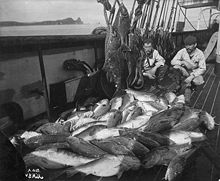District of Alaska
By 1884, the civilian population had grown to the point where President Chester A. Arthur signed off on the First Organic Act, and appointed a civil government.
Skagway and the White Pass trail also had a severe crime problem, organized and led by the infamous badman, Soapy Smith.
Barnette, who had been forced to disembark from the steamer Lavelle Young with his entire load of supplies, some of which he sold to Pedro.
The town had shanties on the fringes, but the center offered many of the economic conveniences of the rest of the U.S. Traffic came through the river, and an overland route to Valdez cut days off a trip to the contiguous United States.
Eventually, the Tanana Mining District became a huge gold producer, and the metal attracted Americans and Europeans alike.
Ruby grew from a tent city in 1911 to a river port and then had running water in summer, a theater, shops, and cafés.
In 1883 the Arctic Pack Company established a cannery at Nushagak Bay in Southwest Alaska, where they were able to exploit the immense runs of salmon.
The Aleuts soon suffered severe problems due to the depletion of the fur seals and sea otters which they needed for survival.
The Americans also expanded into the Interior and Arctic Alaska, exploiting the furbearers, fish, and other game on which Natives depended.

